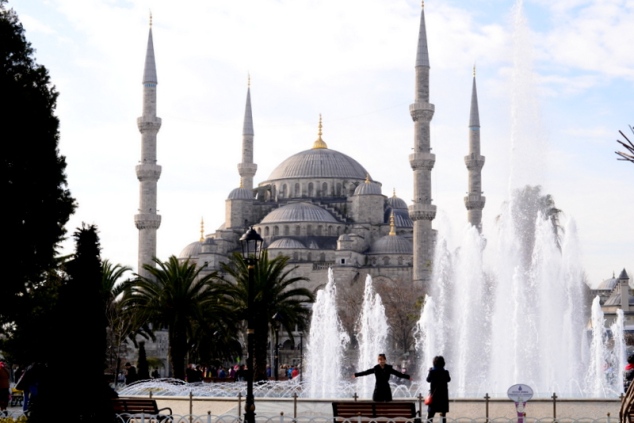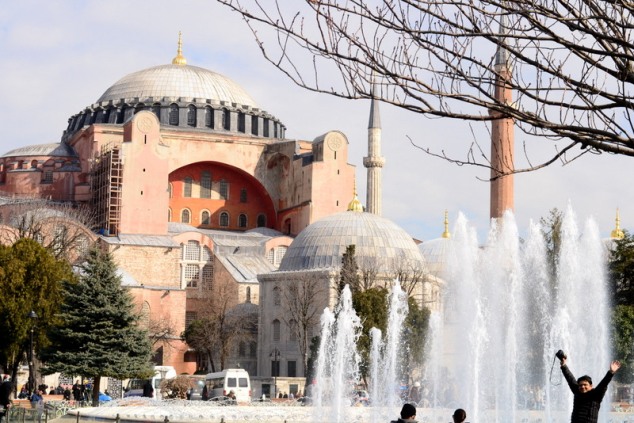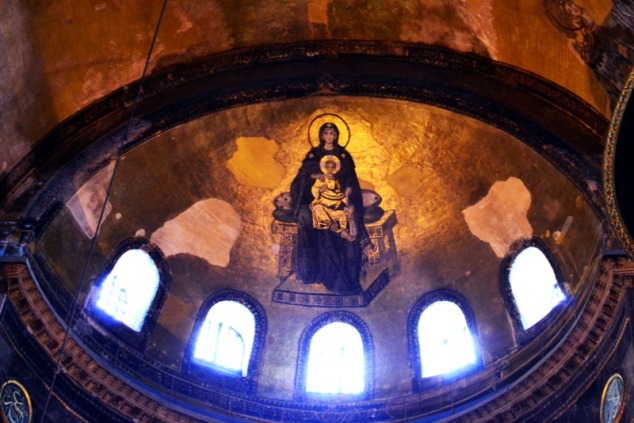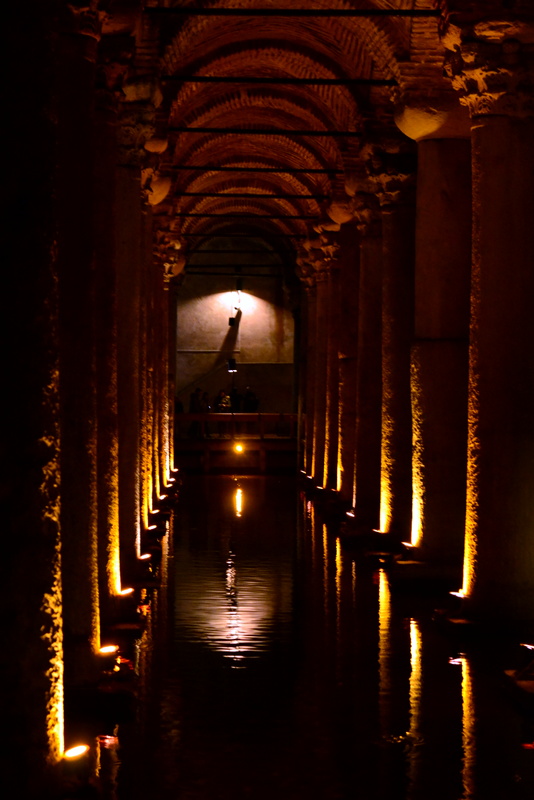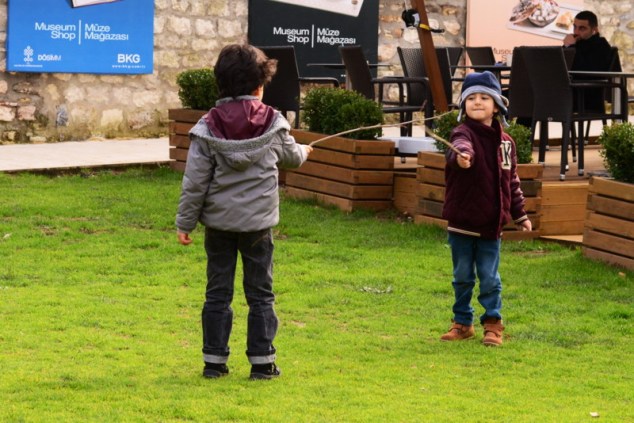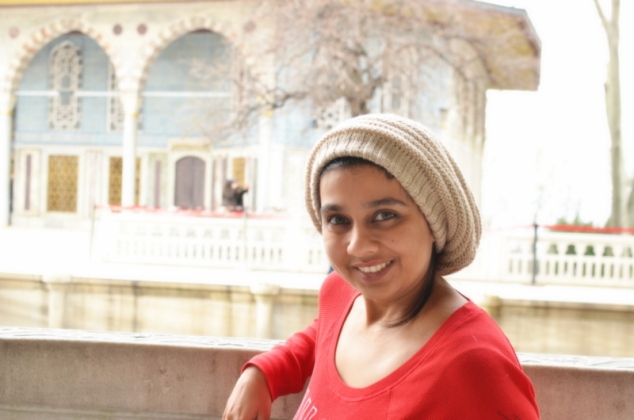January 29, 2015
Most tourist attractions in Istanbul are close to tram stations and walking distance from each other. If you start early, you can cover a lot of ground. We had seen the Hippodrome the previous night, on our way back from dinner at the lovely Khorasani Restaurant recommended by AntheasChronicles. The Hippodrome is not an enclosed space and can be seen as early or late as you like. Since the Hippodrome is adjacent to the Blue Mosque (the Sultanahmet Camii), and the visitor entry to the Blue Mosque is from this side, our original plan was to do it early in the morning before going to the Blue Mosque. In the morning, we followed another set of tourists and ended up walking all around the mosque, before finally going in. This was not a bad thing at all because it gave us the opportunity to admire this magnificent structure from every angle. The architecture is a striking mix of traditional Islamic architecture and Byzantine elements. Mosques traditionally have one, two or four minarets. What makes the Blue Mosque unique is that it has six minarets, one of which was under repair. It says online that women need to cover their hair and shoulders inside the mosque, however it is not enough if you cover all your hair with a cap, you need to wear a headscarf, which is helpfully provided free of cost to all tourists. The mosque gets its unofficial name from the 20,000 sixteenth century blue tiles of Iznik design that line its high ceiling. The oldest of these tiles feature flowers, trees and abstract patterns. It is a little disappointing if you’re looking for lots of blue because the blue tiles are mostly in the inaccessible upper galleries. The interiors were once lit by two hundred and sixty windows, filled with stained glass of the seventeenth century. Today, one can only imagine the grandeur.
The husband was quite keen on checking out this imposing edifice opposite the mosque, while I was determined to stick to schedule. Turns out both of us got our way. That beautiful building was the Hagia Sofia, the next stop on our list. If there ever was a building that could tell a story, this would be it. I can almost hear her speak in a deep faraway voice, saying,” I was once a temple dedicated to Gods long forgotten. Food, wine and precious objects would be offered here to bribe and curry favour with the deities. Sometimes animals would be sacrificed and the offal burnt as an offering. Back then this city was called Byzantium….”
Somewhere around the 4th century AD, the city was rebuilt as the eastern capital of the Roman Empire by Emperor Constantine I christened Constantinople. Emperor Constantine the Great ordered a “Great Church” to be built on the site on the old pagan temple. When Patriarch John Chrysostom was sent into exile by the Emperor Arcadius in 404 AD, rioters burned down this wooden-roofed basilica. On the orders of Emperor Theodosius II, a second church was built on the charred remains. The second church was completely destroyed during the Nika Revolt in 532 AD. Emperor Justinian the Great, with some inspiration from his wife (purple makes a fine shroud) suppressed the riots, and commissioned two *mechanikoi, Anthemius of Tralles,a mathematician and physicist,and the Elder Isidore of Miletus, a professor of geometry and mechanics to build greater and grander church in place of what had been destroyed. Interestingly, neither of them is known to have any prior building experience, yet what they created was recognized as a major work of architecture of its time. More than ten thousand people worked for the construction and the third church was inaugurated by the emperor in 537 AD.
The Hagia Sophia has been damaged several times by earthquakes and fires, and each time it has been repaired and rebuilt. The decorations inside the church have changed to reflect the religious views of reigning monarchs. With the Latin occupation of Constantinople between 1204 and 1261, the church became a Roman Catholic cathedral. In 1261, Byzantines recaptured Constantinople and it became a Eastern Orthodox church again. It was said that Muhammad,the prophet of God in Muslim religion, had prophesied that the first Muslim to pray in Hagia Sophia would go to paradise. Don’t ask me why, I don’t understand either, but it was said and since it was said it was a great ambition for Muslim leaders of those times to get into Hagia Sophia.In 1453 when Istanbul fell to the Ottomans, Sultan Mehmet II went straight to Hagia Sophia and ordered that this Byzantine cathedral be converted into a mosque. In the following years, Sultans added, strengthened and restored the building. Finally in 1934, Mustafa Kemal Ataturk, the founder of Turkish Republic, ordered the building to be transformed into a museum. The white plasters covering the mosaics were taken off, carpets on the floor were removed and for the first time in centuries, the original marble décor could be seen. The Hagia Sophia Museum opened on 1 February 1935.
The tiered structure of the Blue Mosque, the cascading domes, perfect proportions and elegant curves make it as gorgeous a rival as intended to the Hagia Sophia. Inside, however, the Hagia Sofia with its cavernous, seemingly unsupported dome, artistic motifs, jewel-like mosaics and richly coloured frescoes was far more impressive.
Stand under the main dome of the Hagia Sophia and whirl like a dervish, as fast as you can. When the world around you starts to spin, look you and see the seraphim on the vaulted ceiling fly.
The entrance to the Basilica Cistern is across the street from the Haghia Sophia. This marvelous piece of engineering was built during the reign of Emperor Justinian I in 532 to meet the water needs of the Great Palace, which once stood where the Blue Mosque stands today. The water was transported to the city center by the 971-meter-long Valens Aqueduct (Bozdoğan Sukemeri) and the 11.545-meter-long Mağlova Aqueduct (Mağlova Sukemeri), and stored in this immense underground water container. The cistern is 143 meters long and 65 meters wide and could hold upto 80.000 cubic meters of water.The cistern forgotten for centuries, was accidentally rediscovered in 1545 by a Frenchman who noticed that people in the neighborhood simply lowered buckets through holes in their basements to get fresh water. At the far left hand corner of the cistern are two Medusa heads, mysteriously positioned – one upside down, and the other tilted to the side, used as column bases. .
Time seemed to be on our side. We spent as much time as we wanted inside the Blue Mosque, Hagia Sophia and the Basilica Cistern, and surprisingly by the time we were done, it was only lunch time. Rearranging our schedule a little, we visited the Topkapı Palace in the afternoon. Topkapı Palace was the primary residence of the Ottoman sultans for approximately 400 years. With its tree- shaded courtyards surrounded by functional buildings; each courtyard serving a different purpose and opening into the next through monumental gates, Topkapı is a classical example of Turkish palace architecture. Each sultan added and altered the palace according to his tastes and requirements.
The pavilions in the fourth court were by far my favourite part of the palace. The court and the treasury were grand no doubt, but the tastefully done pavilions with gardens on one side and views of the Bosphorus on the other are what royal life is all about. On a break from weighty affairs and lengthy discussions with crafty statesmen, I imagine the sultans would be drawn to this courtyard by the sweet scent wafting in from the gardens. Shaded from the afternoon sun, cooled by an occasional breeze from the great river, the pavilions would make a ideal place for an afternoon siesta. I can imagine myself curled up here with a stack of books and a flask of sumac sherbet.
After the 17th century, the Topkapı Palace gradually lost its importance and in 1856, Sultan Abdül Mecid I finally moved his court to the newly built Dolmabahçe Palace, the first European-style palace in the city. When the rule of the Ottoman Empire ended,Topkapı Palace was transformed into a museum of the imperial era in 1924. The museum displays large collections of porcelain (rumored to be prized by sultans not just for their beauty but also because they changed colour on contact with poison), robes, thrones, weaponry, Ottoman miniatures, Islamic calligraphic manuscripts and murals, as well as Ottoman treasures and jewelry. The sprawling courtyards, aesthetic pavilions and fabulous jewel-filled treasury (and extensive Harem which we did not visit) allow a glimpse into the lives of the Ottoman royals.
*mechanikoi – masters of the science of mechanics
P.S –Check out the Istanbul, Turkey album our FB page to enjoy our journey through pictures.

